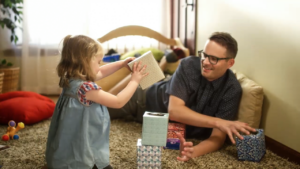Have you ever watched your child take random pots and pans from the kitchen and turn it into a fun game of rock band? Has your child taken leaves, sticks and stones and designed a town in your backyard? These are examples of “loose parts” play.
Loose parts are a collection of objects that can be used in a variety of ways for play. Using objects in their immediate surroundings allows children to use their imagination; it encourages them to creatively choose how they play.
How can we use loose parts to promote coping, specifically in relation to our child’s illness or hospitalization? Here are a couple ways you can get started:
- Use loose parts to help them communicate their understanding of a procedure or diagnosis. Have your child gather loose parts from their (hospital) room or living space, and use them to teach back their understanding. What can they find in their surroundings that explains what their diagnosis is?
- Use loose parts to help them prepare for a test or procedure. If you don’t have access to medical equipment that can be used for play, no problem! Loose parts from your surroundings can be used creatively as medical equipment when acting out the steps of an upcoming test or procedure.
Do you need some inspiration? During last month’s Upopolis UMeet, a monthly virtual programming session for our youth members, the theme was loose parts! We encouraged youth to explain a procedure or diagnosis. Our intern explained an intravenous (IV) needle using a headband as a tourniquet, a sticky note for a disinfectant wipe, a pop tube fidget toy to represent the “straw” of the IV, and a pen to represent the needle.
One youth shared their experience of getting an x-ray; they used a teddy bear, make up mirror and pillow to describe the steps of the procedure. Afterwards we were able to reflect on how easy, fun and effective it was to use loose parts to describe medical experiences.
Using every day household items creates a safe and familiar space for learning; it is also a great opportunity to have dialogue with your child about their feelings, thoughts and fears about upcoming tests or procedures, or their diagnosis. We encourage you to get creative, use your imagination and incorporate loose parts in your child’s play.
